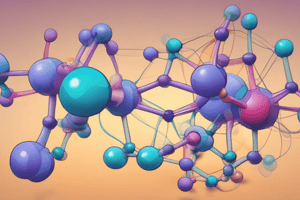Podcast
Questions and Answers
What is a molecule?
What is a molecule?
- A single atom
- A type of chemical bond
- A particle formed by two or more atoms bonded together (correct)
- An element
What is the smallest part of an element that retains its properties?
What is the smallest part of an element that retains its properties?
Atom
What is the charge of an electron?
What is the charge of an electron?
Negative
Atoms can be broken down into smaller pieces.
Atoms can be broken down into smaller pieces.
Na is the chemical symbol for ______.
Na is the chemical symbol for ______.
What does a chemical formula represent?
What does a chemical formula represent?
What is the atomic number of an element?
What is the atomic number of an element?
The atomic mass is the sum of protons and electrons.
The atomic mass is the sum of protons and electrons.
A number placed to the lower right of a chemical symbol is called a ______.
A number placed to the lower right of a chemical symbol is called a ______.
In a chemical equation, what does the coefficient represent?
In a chemical equation, what does the coefficient represent?
What happens during a chemical reaction?
What happens during a chemical reaction?
What particles are present in the nucleus of an atom?
What particles are present in the nucleus of an atom?
The number of protons and electrons is the same in a neutral atom.
The number of protons and electrons is the same in a neutral atom.
How are electrons arranged around an atom?
How are electrons arranged around an atom?
What is the definition of a chemical reaction?
What is the definition of a chemical reaction?
What is a neutron?
What is a neutron?
Flashcards
Molecule
Molecule
The smallest unit of a compound made up of two or more atoms bonded together.
Atom
Atom
An indivisible particle, the fundamental building block of matter.
Proton
Proton
Positively charged particles found in the atom's nucleus.
Electron
Electron
Signup and view all the flashcards
Chemical Symbol
Chemical Symbol
Signup and view all the flashcards
Chemical Formula
Chemical Formula
Signup and view all the flashcards
Chemical Equation
Chemical Equation
Signup and view all the flashcards
Coefficient
Coefficient
Signup and view all the flashcards
Subscript
Subscript
Signup and view all the flashcards
Atomic Number
Atomic Number
Signup and view all the flashcards
Atomic Mass
Atomic Mass
Signup and view all the flashcards
Energy Levels
Energy Levels
Signup and view all the flashcards
Protons and Electrons
Protons and Electrons
Signup and view all the flashcards
Chemical Reaction
Chemical Reaction
Signup and view all the flashcards
Neutron
Neutron
Signup and view all the flashcards
Chemical Reaction
Chemical Reaction
Signup and view all the flashcards
Study Notes
Molecule
- A molecule is formed by two or more atoms bonded together through chemical bonds.
- Represents the smallest unit of a compound.
- Can consist of identical atoms (e.g., O2) or different atoms (e.g., H2O with 2 hydrogen and 1 oxygen).
Atom
- Introduced by John Dalton in 1802 through atomic theory.
- Atoms are indivisible and cannot be broken into smaller parts.
- Atoms of an element are identical, maintaining the element's properties.
Proton
- Protons are positively charged particles found in an atom's nucleus.
- Atoms are incredibly small, with a single grain of sand containing more atoms than grains of sand on a beach.
Electron
- Electrons are negatively charged particles that rapidly orbit the nucleus.
- They are energetic and move in various directions around the nucleus.
Chemical
- A chemical symbol is a shorthand representation of an element, composed of one or two letters.
- The first letter is always uppercase; if a second letter is present, it is always lowercase (e.g., Na for sodium).
Chemical Formula
- A chemical formula combines symbols to represent a compound (e.g., NaCl for sodium chloride).
- It indicates the ratio of elements present in the compound.
Chemical Equation
- Represents a chemical reaction using symbols and formulas.
- Illustrates both reactants and products, similar to a mathematical equation with an "=" sign.
Coefficient
- The number placed before a chemical symbol/formula in an equation.
- Indicates how many molecules are involved in the reaction.
Subscript
- A number positioned lower right of a chemical symbol.
- Specifies the number of atoms of an element within a compound.
Atomic Number
- The count of protons in an atom's nucleus determines the atomic number.
- Organizes elements on the periodic table; for example, copper has an atomic number of 29.
Atomic Mass
- Calculated as the sum of protons and neutrons in an atom's nucleus.
Energy Levels
- Refers to specific locations where electrons are arranged around the nucleus.
- The arrangement of electrons influences an element's chemical properties.
Protons and Electrons
- In neutral elements, the number of protons equals the number of electrons.
- Example: Oxygen, with 8 protons, also has 8 electrons.
Chemical Reaction
- A process in which substances transform into different substances without matter being created or destroyed.
- The mass of reactants equates to the mass of products (e.g., CH4 + 2O2 → CO2 + 2H2O).
Neutron
- Neutrons are neutral particles found in an atom's nucleus (specific details not provided).
Studying That Suits You
Use AI to generate personalized quizzes and flashcards to suit your learning preferences.




